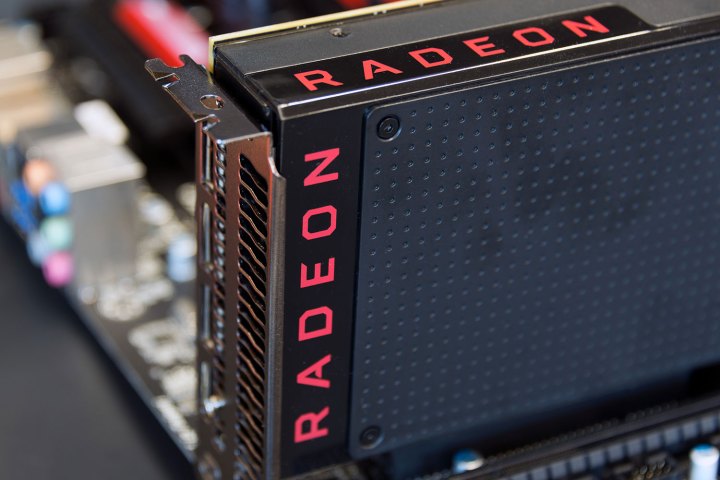
According to AMD, Crimson ReLive Edition provides a slight performance gain over the Crimson 16.6.2 driver suite. In a provided chart, the company states that the new software generates an eight percent increase in performance in Ashes of the Singularity, 7 percent in Batman Arkham Knight, 4 percent in Deus Ex: Mankind Divided, 7 percent in Shadow of Mordor, and 6 percent in Overwatch.
Crimson ReLive Edition is compatible with AMD’s “Kabini” APUs and newer, graphics chips based on its Graphics Core Next (GCN) architecture, and seemingly targets cards based on the company’s fourth-generation GCN “Polaris” design and newer. AMD is undoubtedly setting itself up for the unannounced Radeon RX 490 and Pro 490 cards rumored to arrive this month, as well as solutions based on its next-generation “Vega” chip design.
Crimson ReLive Edition includes a new panel for advanced display settings and diagnostics, such as an automatic bad HDMI cable and signal detection fallback. The updated suite also features VP9 decode acceleration for streaming 4K video at 60Hz, support for Dolby Vision and HDR 10 in PC gaming, a new borderless full-screen mode in AMD FreeSync, Skype performance enhancements for APUs, support for DisplayPort HBR3, and more.
The company is also introducing Radeon Chill with this software release. This is a power-saving feature that regulates frame rates dynamically based on in-game movement. When turned on, the Radeon graphics chip consumes up to 31 percent less power, and up to 13 percent cooler average temperatures in Celsius. The feature enables the GPU to render the frame immediately after its queued rather than waiting to render the frame after the next one is queued, giving the graphics chip a chance to idle between rendered frames.
That said, thanks to this process, there are less frames queued, reducing the response time whereas when Radeon Chill is off, there are more frames queued, leading to an increased response time. According to the company, this aspect provides up to 32 percent lower average frame-time delivery to the display in milliseconds. For instance, a frame would be delivered to the display in 7.1 milliseconds with the feature turned off, and in 4.8 milliseconds with the feature turned on.
Here are a batch of games that support Radeon Chill:
| Team Fortress 2 | Overwatch | Counter-Strike |
| Paragon | CrossFire | Fallout 4 |
| Far Cry Primal | Call of Duty: Infinite Warfare | Deus Ex: Mankind Divided |
| Warframe | Dark Souls III | The Witcher 3 |
| Far Cry 4 | PlanetSide 2 | World of Warcraft |
| Rise of the Tomb Raider | Tomb Raider 2013 | The Elder Scrolls V: Skyrim |
On top of introducing Radeon Chill, Crimson ReLive Edition updates Radeon WattMan to include more than just the Radeon RX 480, RX 470, and RX 460 graphics cards. The utility can now be used with the following:
| Radeon R9 Fury Series | R9 390 Series | R9 380 Series |
| R9 290 Series | R9 285 Series | R9 260 Series |
| R7 360 Series | R7 260 Series |
Other goodies that arrive with Crimson ReLive Edition include AMD XConnect technology support on Thunderbolt-certified laptops, thin clients, and all-in-one PCs, a revamped software installer, an upgrade adviser for PC games sold on Steam within North America, a user feedback tool to provide the Radeon Software Team your personal opinion, and a Radeon Software driver for Linux supporting FreeSync.
Finally, the new Radeon ReLive component optimizes performance when streaming gameplay to major platforms like YouTube, Twitch, Panda.TV, and so on. With this feature turned on, customers will see a frame rate reduction of up to 3 percent while recording in World of Warcraft compared to a larger frame rate drop when recording with Radeon ReLive turned off. The same is true in Overwatch and H1Z1: King of the Hill while Battlefield 1 will only see up to 4 percent in frame rate reduction.
Radeon ReLive provides an in-game, positionable toolbar to make streaming simple. Users merely click once to record gameplay, start a live-streaming session, take a quick screenshot, or open the settings menu without leaving the game. Radeon ReLive also includes a customizable overlay, and is capable of an instant replay of up to twenty minutes. There’s even a version for Radeon Pro cards for capturing professional workflows when using Maya, Premier Pro CC, and more.
Here is a brief rundown of the other included features in the Redeon ReLive Edition suite:
| Radeon Loom: |
|
| OCAT: |
|
| Depth of Field: |
|
| TressFX 4.0: |
|
| Advanced Media Framework 1.4: |
|
| LiquidVR: |
|
| Radeon Pro specific: |
|
Here is a list of bugs squashed in the Crimson ReLive Edition suite, as provided by AMD:
- The Division experienced an application freeze or hang when running in AMD CrossFire Technology mode after extended periods of play.
- Game quality or performance was degraded when launching multimedia content on a secondary display before running a game.
- The CIM folder would remain under Program Files even after complete driver uninstallation.
- Radeon Settings experienced an intermittent crash when accessing Radeon WattMan.
- Display tab with virtual super resolution was removed or missing in Radeon Settings.
- The Radeon WattMan feature would intermittently display a Radeon Software popup error regarding Radeon WattMan for nonsupported products.
- Random crashes were experienced in Mozilla Firefox.
- DirectX 12 content was unable to launch on some older CPUs that do not support popcnt instruction.
- “Pixel Format” options were missing in Radeon Settings with RX480.
- Intermittent Mouse Cursor corruption was experienced on RX480.
Needless to say, Crimson ReLive Edition is AMD’s biggest software release to date. Head over to AMD now to grab the driver suite for Radeon and Radeon Pro cards.



